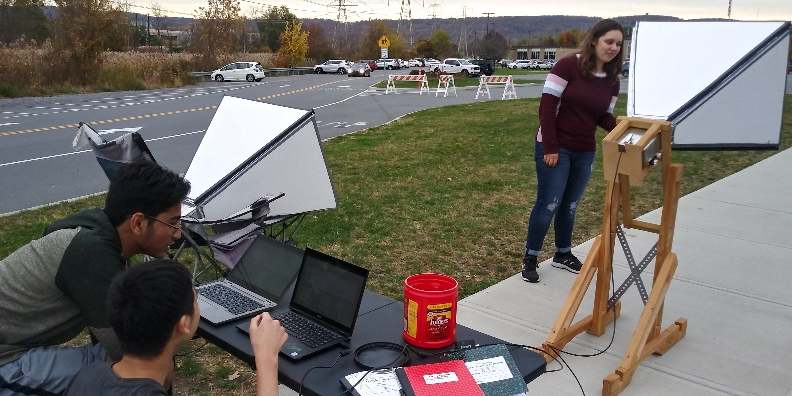This is a fairly intense sequence of activities for High School+ level students with the goal of eventually taking measurements with the DSPIRA Radio Horn Telescope to determine the Earths Speed around the Sun. The reference point to measure this speed with be the Center of the Galaxy (GC).
Click here for a complete document of Teacher’s Notes for this whole activity sequence
There are (up to) 6 activities to get to using the Horn Telescope
Activity List
- How Fast Are We Moving?
- Modeling Earth’s Motion Around the Sun
- Earth’s Motion With Respect to Galactic Center
- A teacher created Doppler Effect Lesson -(Currently, no DSPIRA Activity here)
- Analyzing DSPIRA Radio Horn Data
- Comparing Model to Data
- Getting your own data with your Radio Horn
1. How Fast Are We Moving?
This activity is a stand alone activity that is a good simple exercise for students from general middle school space science up to high school physics students to determine the speed of the Earth’s rotation, revolution around the Sun, and the Sun’s speed around the Galaxy.
>To get to the activity files, click here How Fast Are We Moving?
2. Modeling Earth’s Motion around the Sun
The Earth will be modeled as moving in a circle around the Sun. The direction to the Center of the Galaxy(GC) is also included becuase it will eventually be needed for the measurements. Since the amount of the Earth’s motion towards the GC is eventually needed for Doppler considerations, a graphical approach to velocity vector components is used here.
> Click here for Student Activity Document
> Click here for Student Activity Diagram
> Teacher Hint Video for Activity
3. Earth’s Motion with respect to the Galactic Center
The Earth’s Orbit Model generated in the last activity is fine, but the Day #’s in the activity need to be tagged to an actual calandar date. This activity uses the online planetarium program Stellarium Web Online to help connect the calendar to the student’s model they created.
> Click here for Student Activity Document
> Teacher Hint Video for Activity
Stellarium - Web vs Download Version
Stellarium is a great application for anyone wishing to look at the night sky, or for teachers wanting students to learn about the sky through an interactive experience.
If you get into the full DSPIRA Experience with making and using a Radio Horn Telescope, you would probably want to take the longer learning path to the more robust environment of the downloadable version (still currently free). Watch the video for a DSPIRA opinion on Pros and Cons for each version.
> Video Stellarium Web vs Download version
4. Introduction to Doppler Effect
There is not a DSPIRA generated activity for Doppler. The next activity will require using the Doppler equation given in the activity, but the students should be
exposed to it first through a teacher generated lecture.
Here is a quick 3 minute video that introduces the Doppler Shift, and in the last minute, it discusses how astronomers use it to detect motion.
> Popular Youtube Doppler Shift Video
5. Measuring the Earth’s Speed around the Sun
Actual data generated from the DSPIRA Radio Horn Telescope is given to the students to analyze. It is a great opportunity for students to learn to dig information out of a graph. The data lines up with the points created in the Earth Orbit Model from activity #2. The students will use the Doppler equation to determine the (radial) speed of the Earth towards the Galactic Center.
> Click here for Student Activity Document
The following video shows an example of how to analyze the Spectrum in the manner of the activity. It can help the teacher or student get started with the analysis part of the activity.
> Video of Graph Analysis Example
6. Comparing the Earth Orbit Model to the actual Data Analysis
There has been a long sequence of activities that brings a class to this point. This is actually a quick activity to direct the students to take all the work they have done so far and put it into one Conclusion/Final Comparison chart.
> Click here for Student Activity Document
If each student truly has done their own work throuhg this process, they will all have slightly different values (for the skew between velocity of model and actual data)
This is an opportunity to gather the whole class data and discuss the results. Here is a spreadsheet that a teacher can open, then make a copy that they can allow the students to share and enter the data. Their data on the spreadsheet has typically yielded a nice histogram. This allows the students, and you the teacher, to quickly assess how an individual student’s results compare to the rest of the class. There is an example worksheet (lower tabs) to look at once the spreadsheet is open.
> Click here Class Data Spreadsheet
7. Students Gathering Data
If you have a DSPIRA Radio Horn Telescope and the electronic means to use it, then there is an opportunity to have the students gather actual data from the Center of the Galaxy and run their own spectrum through the same set of analysis that was done in this activity sequence (namely, acitivities 2, 5, and 6)


*Students Observing the Galactic Center with a Radio Horn
Video coming soon! How to go from choosing an object to observe to actually setting up the Horn Telescope and making the Observations